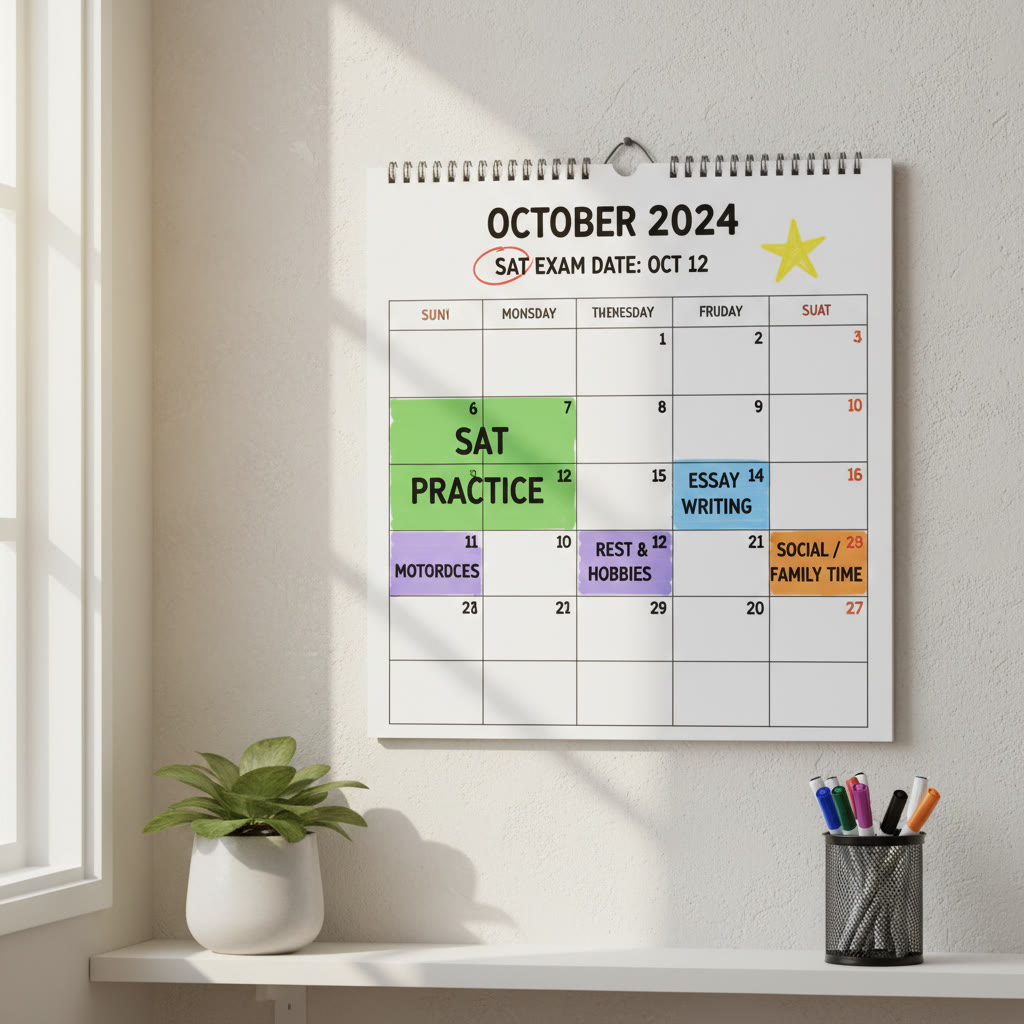How to Balance SAT Prep With College Essay Writing: A Practical Roadmap
When you wake up and realize both the SAT test date and your college application deadlines are on the horizon, a cold dose of panic can be tempting. You might imagine two separate trajectories—weeks of practice tests in one lane and late-night essay drafts in another—that are doomed to collide. The good news? They don’t have to. With a realistic plan, a few practical techniques, and some smart triage, you can move forward confidently on both fronts.
Why balancing both matters (and why it feels hard)
The SAT and college essays test very different skills. The SAT rewards pattern recognition, strategy, endurance, and timing. The essay rewards reflection, clarity, narrative, and voice. Both, however, reward planning and focused practice. Trying to sprint through SAT questions while also squeezing out a vulnerable, 650-word personal statement usually produces mediocre results on both. The pressure is real, but so is the solution: thoughtful allocation of time and energy.
Start by clarifying priorities
Before you build a schedule, answer three questions honestly:
- How close is my SAT test date relative to application deadlines?
- What score do I realistically need, and how far am I from it now?
- How many essays (and supplements) do I need to write, and how polished must they be?
If your test date is weeks away and your score still needs substantial improvement, ramp up SAT practice and set essay milestones that fit around test blocks. If essays are due before your next SAT, flip the emphasis and secure strong drafts first. The key is flexible prioritization rather than rigid, equal-split schedules.
Principles that make juggling feasible
Think of balancing SAT prep and essays as a project-management problem. Use these guiding principles:
- Block schedule: create predictable blocks of time for focused work so switching costs shrink.
- Deep work vs light work: do intense SAT practice in high-energy windows; reserve lighter revision tasks for lower-energy periods.
- Iterate: essays improve with cycles of drafting and feedback; SAT scores improve with cycles of practice and review.
- Buffer time: always add breathing room before deadlines for unexpected edits or missed study sessions.
Designing a weekly blueprint
Below is an example weekly plan that balances both demands for a student with about 12–15 hours per week to devote to college prep. Adapt quantities depending on how many weeks you have left and your personal rhythm.
| Activity | Hours per Week | Why it works |
|---|---|---|
| SAT focused practice (timed sections) | 5 | Maintains test rhythm and timing under pressure |
| SAT review (error analysis & targeted drills) | 2 | Converts mistakes into lasting learning |
| Essay brainstorming & drafting | 3 | Builds ideas gradually without last-minute stress |
| Essay revision (feedback incorporation) | 1.5 | Polishes voice and clarity with outside input |
| Administrative tasks (applications, supplements) | 1 | Keeps deadlines and requirements organized |
| Rest & buffer | 1.5 | Prevents burnout and allows flexibility |
This plan is a template, not a rule. If you have just a month before the SAT, push practice to 8–10 hours and compress some essay work into short daily drafting slots. If essays are due sooner, shift hours accordingly and schedule a diagnostic SAT closer to test day.
Sample daily rhythms
A day that supports both goals might look like this:
- Morning (60–90 minutes): Timed SAT section or practice set when you’re fresh.
- Afternoon (30–60 minutes): Quick review of errors and a targeted grammar drill or vocabulary flashcards.
- Evening (45–75 minutes): Essay brainstorming, freewriting, or revision—short, focused sessions win over marathon late-night editing.
Efficient SAT practice: quality over quantity
Not all practice is equal. Ten well-reviewed questions do more than 50 rushed ones. Use these tactics to get the most out of your SAT study:
- Start with a diagnostic to identify the biggest score levers (e.g., timing, algebra, sentence structure).
- Use timed sections to mimic real conditions. The SAT is partly an endurance game.
- Track error patterns. Create a two-column log: question type on the left, fix/strategy on the right.
- Do targeted drills. If you miss geometry repeatedly, set aside short drills focusing only on that topic.
- Simulate a full practice test every 2–3 weeks to build stamina and measure progress.
An example error log entry
This is a simple but powerful way to learn from mistakes.
- Question: Algebraic manipulation, multi-step
- Mistake: Sign error while distributing
- Strategy: Slow down during distribution; rewrite equation before simplifying
- Follow-up drill: 10 distribution problems with time limit = 12 minutes
Writing college essays without sacrificing scores
Essay-writing is iterative. It thrives on space and feedback. Here’s a sequence that often produces calm, strong essays while freeing time for SAT work.
- Brainstorm early: collect anecdotes, turning points, values, and quirks in a running document.
- Freewrite drafts: aim for ideas, not perfection; set a timer for 20–30 minutes.
- Let it rest: step away for 24–48 hours if possible—distance reveals what’s essential.
- Revise for structure, then for voice, then for sentence-level clarity.
- Seek targeted feedback: a trusted teacher, counselor, or an expert tutor who can read for authenticity and coherence.
Often, modest daily increments are more effective than a single all-night scramble. A 45-minute session three times a week yields steady progress and keeps your mind fresh for SAT practice.
Two drafting strategies that pair well with SAT study
- Micro-drafting: Write one paragraph per session—intro one day, scene another, reflection another. These short wins add up and don’t crowd out study time.
- Block drafting: Dedicate a longer block on a weekend (2–3 hours) to produce a full draft, then return to SAT practice with a lighter touch during the week.
Practical integration tips: make them complement each other
Rather than viewing the SAT and essays as competing demands, look for ways they can reinforce each other:
- Use reading material that benefits both: high-quality opinion pieces and narrative essays sharpen comprehension for the SAT while providing models of voice for your own essays.
- Turn SAT reading practice into essay fuel: annotate passages and note striking turns of phrase or structure you might adapt in your own voice (without copying).
- Schedule low-intensity essay tasks on SAT-heavy days—things like reading feedback or organizing drafts—so you keep momentum without burning cognitive resources.
Example crossover exercise
Choose one SAT reading passage a week and do the following:
- Highlight the thesis, evidence, and rhetorical moves.
- Write a 200-word reflection on how the author builds momentum—notice transitions, pacing, and concrete detail.
- Keep the reflection as a model bank for essay transitions and techniques you can adapt to your own story.
When to ask for outside help
Getting feedback is critical. But what kind of help, and when? Consider these trigger moments:
- Your SAT score has plateaued after several weeks of solo study. An expert tutor can identify subtle strategic changes that produce gains.
- You have multiple essay prompts and limited time. Personalized guidance can prioritize which essays need deepest polish.
- You want trained eyes for feedback that preserves your voice while tightening structure and grammar.
Sparkl’s personalized tutoring can fit naturally here: when you’re juggling practice tests and drafts, tailored 1-on-1 guidance, expert tutors, and AI-driven insights can target weak spots quickly and keep both SAT and essay progress moving. A tutor who understands your profile can recommend how to shift hours week-to-week without losing momentum.
Managing stress and avoiding burnout
It’s easy to equate busyness with productivity. Instead, aim for sustainable intensity. Consider these small but high-impact habits:
- Sleep first: cognitive performance drops steeply without consistent sleep; save late-night marathons for true emergencies.
- Micro-breaks: use the Pomodoro method or 45/15 cycles to refresh your focus.
- Celebrate incremental wins: a higher practice-test section score, a clean early draft—these milestones matter.
- Communicate deadlines: let teachers and family know your schedule so they can support focus blocks.
Quick mental reset script (2 minutes)
When anxiety spikes: close your eyes, breathe in for four counts, hold two, breathe out for six. Repeat four times. It reduces physiological reactivity and improves concentration immediately.
Concrete checklists and timelines
Use checklists to make progress visible and to avoid the last-minute scramble. Below are two brief templates you can adapt.
SAT 6-week checklist
- Week 1: Diagnostic test; identify weakest areas; schedule practice-test dates.
- Week 2: Focus on high-leverage topics; timed practice sections twice.
- Week 3: Full practice test; error log deep dive; targeted drills.
- Week 4: Address endurance—take another full test; review timing strategies.
- Week 5: Light practice; focus on confidence-building and strategy refinement.
- Week 6: Final review, simulate test-day routine, rest the day before.
Essay short-term checklist (6 weeks)
- Week 1: Brainstorm multiple topics; gather anecdotes and details.
- Week 2: Write a quick draft of your primary essay (freewrite).
- Week 3: Receive first round feedback; revise structure and opening.
- Week 4: Second draft; polish voice and vivid details.
- Week 5: Final feedback round and line edits.
- Week 6: Proofread, format, and finalize supplements.
Sample scenarios and how to adapt
Here are two real-world scenarios and how to respond.
Scenario A: Two months to the SAT and essays due in three months
Prioritize SAT practice first. Use intense 8–10 hour weekly SAT blocks for the next six weeks while maintaining a light essay schedule: 2–3 short drafting sessions per week and a weekend block for a full draft. After the test, shift to heavier essay revision.
Scenario B: Essays due in four weeks and SAT in six weeks
Focus on essays now—produce full drafts and at least one polished essay for applications. Keep SAT work to maintenance mode: timed sections twice a week and one full practice test every two weeks. After essay deadlines, increase SAT intensity.
Measuring progress without losing perspective
Progress looks different for tests and writing. For the SAT, aim for measurable metrics like section scores and timing improvements. For essays, track qualitative progress like clearer structure, stronger openings, and feedback resonance. Keep a small weekly journal: two lines on what improved and one line on what to change next week. Over time, these notes become a blueprint for steady improvement.
Final checklist before deadlines
- Confirm test-day logistics: registration, ID, calculators, and directions.
- Submit essays at least 48 hours before the deadline to avoid last-minute technical issues.
- Do one calm, timed practice test two weeks before the SAT; avoid cramming the final week.
- Make backup copies of essays and keep a short list of recommenders and deadlines.


Parting thoughts: small, consistent actions win
Balancing SAT prep with college essay writing is less about heroic all-night sessions and more about steady, strategic work. Prioritize according to deadlines and score goals, build predictable routines, use focused practice and feedback, and protect your sleep and sanity. If you feel stuck, tailored help—like Sparkl’s personalized tutoring with 1-on-1 guidance, tailored study plans, expert tutors, and AI-driven insights—can help you allocate time smartly and make faster, more confident progress.
Above all, remember this: the SAT tells one kind of story about your academic readiness, and your essays tell another—your character, curiosity, and individuality. Treat both with respect, but don’t let the perfect be the enemy of the good. With a clear plan and steady work, you can arrive at both a strong score and essays that truly reflect who you are.
Quick action plan (tomorrow)
- Take a short timed SAT section to feel the format.
- Spend 30 minutes brainstorming three essay ideas—choose one to expand.
- Block two focused study periods on your calendar (one for SAT, one for essay).
Do those three things, and you’ll have momentum. Momentum makes everything easier.

















No Comments
Leave a comment Cancel